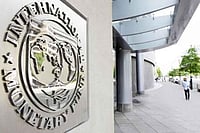CHINESE President Jiang Zemins visit to India is significant in bilateral terms. But it cannot really be detached from his overall South-east Asian and South Asian diplomatic initiatives, in which he toured the Philippines, Pakistan and Nepal too. The South Asian focus in Chinas foreign policy was emphasised in the itinerary itself: he visited three of the seven SAARC countries. At the same time, a certain realism and precision was reflected in the choice of three countries which have borders with Chinaand ties with which impinge directly on Chinas geopolitical interests.
There was much speculation in India that his visit would herald a quantum improvement and a qualitative move forward in Sino-Indian relations, particularly vis-a-vis controversial bilateral issues. As the outcome proved, these remained what they were, essentially speculative. Descriptive information recall about the concrete results of this visit is pertinent. Four agreements were signedthree of a routine nature calling for tie-ups in different fields and stipulating arrangements for Indias mission in Hong Kong after July 1997. The fourth, of a politico-security nature, pertained to holding further confidence-building measures (CBMs) and implementing the September 1993 pact on maintaining peace and tranquility on the Line of Actual Control (LAC).
The additional CBMs are certainly a step forward in defusing tension on the frontier. The measures agreed upon are basically a linear evolutionary exercise stipulated and planned in the 93 agreement. The doctrine governing the concept of "equal and mutual security" was specifically mentioned there. The new CBMs cannot be perceived as a real breakthrough, but they are a part of normalisation of relations. That this is a troubled process is shown by what didnt happen during Jiangs visit. The absence of the anticipated pact on investment, of progress on border trade and of any specified target for the volume of bilateral trade indicates that neither country assesses the others potential complementarity too highly.
Jiang fulfilled a significant diplomatic objective by including Tibet Governor Gyaltsen Norbu and another representative of Chinas Tibetan Government in his delegation. Perhaps he was testing the substance of Indias Tibet policyto see if India would object to their presence. We did not, which was in conformity with our policies on Tibet since 1954. But this would be perceived by the Tibetans and the international community as Indias decision to ignore Tibetan religious and political sensitivities.
On the boundary question, it seemed that apart from calling for a rational and peaceful handling of the substantive aspects, the basic approach was not to move forward on this issue. I perceive a certain danger in this approach. The 1993 pact about maintaining peace on the LAC was signed on the clear understanding that the LAC will not become the boundary between India and China. Also, that the boundary question would be addressed in substance, building on the pacific atmosphere sought to be created on the LAC.
We should be aware that China has no interest in changing the current status of the Sino-Indian border. It would be happy with the LAC congealing itself into a sort of permanent border. It is India which should be interested in coming to a permanent, rational settlement to redress the events of 1962. If the focus of attention remains on stabilising the LAC, Indias basic interests might drift into oblivion. Indian hesitations regarding raising substantive aspects of the boundary issue with the Chinese could defeat the purpose of the 1993 pact as well as the important objective of finding a fair and just settlement.
While our President articulated Indian concerns about certain elements in Chinas regional policies in terms of our national security, one understands that in bilateral discussions with Jiang, we mentioned our worries only in conceptual and macro-level policy termsparticularly Chinas nuclear missile and defence supplies cooperation with Pakistan. One could criticise this approach, but, in my view, indulging in a breast-beating exercise with the Chinese on their cooperation with Pakistan would not have behoved India, nor would it have resulted in any modification of Chinas policies. This was evident from the Chinese spokesmans assertion that Chinas defence cooperation with Pakistan does not pose any threat to Indias security. Jiang, of course, talked about the positive potentialities of Sino-Indian cooperation for ensuring peace, development and prosperity in the whole Asian region. He also talked about the civilisational linkages between India and China as the basis for a durable and fruitful relationship.
But Chinese policies were more candidly articulated in Islamabad where he assured the Pakistanis that Beijing would continue to cooperate with Islamabad in its nuclear and space activities "for peaceful purposes"! More significantly, he said China is in favour of a nuclear weapons-free zone in South Asia and the declaration of the Indian Ocean region as a zone of peace. The latter point was reportedly reiterated in Kathmandu. The conclusion is inescapable:while China, unlike other nuclear powers, is not inclined to generate direct bilateral pressure on India, its basic stance on these issues is the one shared by all the nuclear powers. We should not have any illusions on this.
While Jiang was equidistant and impartial on Kashmir, he was sophisticated but purposive in assuring both the Nepalese and the Pakistanis about Chinas willingness to safeguard their interests against any incipient Indian or other hegemonism. His overall objectives, which he fulfilled, were to indicate to Chinas South Asian neighbours its interest in consolidating relations with them in a manner which would subserve Chinas vital interests in terms of security, stability and territorial integrity. Secondly, to project China as a balancing and influential factor against domineering tendencies in South Asia from within the region or outside. Thirdly, to project Chinas intention of being a major factor in Asian developments in the 21st century.
Overall, one cant escape the conclusion that India was overcautious and reticent in handling this visit and that China determined the agenda and the terms of reference of the discussions. Our Government did not articulate its vision about how Sino-Indian ties should be structured, not only for bilateral benefit, but for fashioning the atmosphere of security, stability and development in the Asian region. Even if it generated an atmosphere of inconvenience or embarrassment, there would have been no harm in conveying our perceptions about Chinas intentions in Asian policies. We have perhaps not got over the defensive psyche of 1962. Combined with this is the subconscious negative perception about China, which may not be fully justified in the changed global situation. Even if India is not a superpower, we should have interacted with China as a major Asian power. It is a pity that we failed to do this.


























